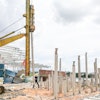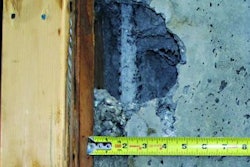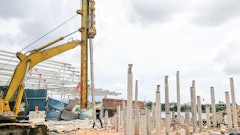PRINCETON, N.J., Jan. 4, 2011 /PRNewswire/ -- The commercial real estate industry struggled through the start of 2010, but by year's end there were signs that conditions worldwide had stabilized and were beginning to improve, according to the 25th annual Global Market Report released today by NAI Global.
After a prolonged, challenging period marked by frozen credit, sidelined investors, stalled development, rising vacancy rates and declining rental rates and property values almost anywhere you turned, improvement, albeit modest, is expected in just about every market sector and geography in 2011.
Much of the activity in 2010 was driven by corporate space users taking advantage of a tenants' market worldwide to lock in low effective rental rates and reduce their overall occupancy costs. Office rental rates in some markets have fallen more than 30% from their mid-2007 peak. This activity is expected to increase as economic growth returns, further unleashing significant pent-up demand.
"Although 2010 was another very challenging year for the industry, we began to see clear signs that the global economy and commercial real estate markets had stabilized and were beginning to improve with a noticeable pickup in transaction volume around the world," said Jeffrey M. Finn, President & CEO of NAI Global. "Companies around the globe are taking advantage of the current market, extending or renegotiating leases, securing investment properties, disposing of underperforming assets and finalizing plans for growth in the next 24 months. We expect a much more active market for buyers, sellers and occupiers as conditions continue to improve."
The investment market also showed signs of life in 2010 as credit markets thawed. The massive wave of foreclosures that was predicted heading into 2010 never materialized as financial institutions opted to extend or re-work troubled loans. However, the sidelines are growing crowded with REITs, private equity and institutional investors who have amassed a tremendous amount of capital and are actively looking for deals, said Finn. Commercial real estate investment should also get a boost from new investors drawn to real estate in pursuit of yields and further enticed by record low interest rates.
Markets across the U.S. are showing signs of recovery, as are parts of Asia, Europe and Latin America. But financial collapses in countries like Greece, Iceland and Ireland are endemic to the rocky global recovery. For every Brazil and China, countries that are showing signs of strong growth, there are contrary markets like Spain that are showing signs of a prolonged recession.
"The real estate market's near-term future is all about the strength and timing of the economic recovery," added Dr. Peter Linneman, NAI Global Chief Economist and Principal at Linneman Associates. "Job growth will be key, as a recovery without jobs does not fill much space. As jobs are created, nearly 2 million new households will form and consumer confidence will rebound, leading to a rebound in corporate profits and economic stability. The momentum building at the end of 2010 points to a hopeful outlook for 2011."
NAI Global is the premier managed network of commercial real estate firms and one of the largest real estate services providers worldwide. Headquartered in Princeton, New Jersey, NAI Global manages a network of 5,000 professionals and 350 offices in 55 countries. Now in its 25th year, NAI's Global Market Report offers insider insight and perspective on market conditions reported by NAI experts on the ground in over 200 property markets worldwide. To obtain a copy of the full report, contact [email protected]
Select U.S. Markets Highlights
Class A Office space in the CBD, especially hard hit during the recession, saw leasing activity increase in 2010 as space users took advantage of a tenants' market to lock in low rates or upgrade from lower-quality space. While not yet a cause for celebration, it was enough to shave a half-point off the national average vacancy rate for downtown Class A office space, which declined from 13.8% in 2009 to 13.3% in 2010 after rising almost 35% the previous year. The national average rental rate for Class A space in the CBD slipped 14.1% from $37.11 in 2009 to $32.51 in 2010, after falling more than 24% the previous year.
The nation's retail markets also appear to have stabilized. While some markets still struggle to fill big boxes vacated by national chains, others have seen new entries and local retailers upgrading to better locations. The national average vacancy rate for downtown/CBD retail space stood at 8.2% in 2010, down from 8.9% in 2009, while rents slipped from $39.90 in 2009 to $39.79 in 2010.
Industrial markets appear to be on the mend. While demand for weak warehousing space continues to be weighed down by weak consumer demand, the market has benefitted from a diminishing pipeline of new construction. Vacancy rates for bulk warehouse space stood at 10.7% in 2010, down from 10.9% in 2009. Rental rates slipped from $4.60 in 2009 to $4.55 in 2010.
Atlanta: The office market has begun to gradually rebound. Leasing activity has increased, but this activity is dominated by consolidation and downsizing, so the activity does not translate to lower vacancy. There has been a noticeable increase in the total industrial leasing and sales activity and a decrease in the amount of negative net absorption over the last several years. The retail market will continue to adjust itself with some vacant centers that were ill-conceived. Vacancy rates are high in many areas and rent adjustments downward continue to press landlords.
Boston: Downward velocity in the office market appears to be slowing. Vacancy rates increased to 14.1% and Class A rents decreased to $32/SF. The industrial market has been slowed by the recession, but has not seen a dramatic rise in vacancy. The retail market did not experience much change in market conditions from 2009 to 2010.
Chicago: The office vacancy rate, on the rise for two years, leveled off at 17% in the second half of 2010. New construction and redevelopment projects will remain sidelined until some of the more than 22 million SF of vacant space begins to be steadily absorbed and demand returns. Industrial vacancy rates peaked at 12% but improved in the second half of the year.
Dallas-Fort Worth: Office supply exceeds current demand, making it a tenants market with a vacancy rate of 20%. There is a marked increase in absorption and occupancy rates should increase significantly in 2011. Dallas industrial vacancy stands at 12.5%, as tenants maintain the upper hand. Speculative industrial starts could be seen by the end of 2011. The Fort Worth retail market can expect to see stabilized vacancy by the first quarter of 2011.
Los Angeles: Vacancy rates for new office space remain above 30%. Rental rates are still declining for Class A and Class B space. Industrial vacancy rates have fallen to 8.6% and rental rates continue to soften across the board. Malls and community centers experienced a small increase in rents, and discount retailers and quick-serve restaurants are the most active in the market. Outlet malls also experienced strong tenant interest; these centers maintain very low vacancy rates and strong rental rates.
Miami: The CBD and several submarkets are experiencing 20% vacancy rates in office space, as most large tenants have relocated or renegotiated favorable terms in premier buildings. The industrial market is improving with large blocks absorbed, including a 342,000 SF transaction. Retail demand is rebounding as consumer spending increases. Despite store closings, supply is in balance because of barriers to entry.
Washington, DC: The nation's capital is its strongest office commercial real estate market. It continues its track to recovery propelled by federal government activity in 2010. New York-based restaurant operators saw opportunity in the market and targeted high-traffic venues around Verizon Center in Chinatown.
Select Global Market Highlights
Asia-Pacific Region: Asia is leading the global economic recovery. Asia rebounded swiftly in 2009 and into 2010. Asian region real GDP is expected to grow 7.9% in 2010, driven by better than expected exports and strong private demand. 2011 GDP growth is projected to be 7.3%. Expect continued strong growth in the industrialized markets in East Asia, including Hong Kong, Taiwan and South Korea. Improved investment, healthy consumer spending, robust exports and industrial production will propel growth. Despite measures to cool the China property market and slow credit growth, China grew at 11.1% in the first half of 2010 and is expected to grow at 10% for the year.
Canada: The Canadian economy, led by exports and a strong commodity cycle, performed well through 2010. GDP growth is expected to hit 2.3% in 2011, tempered by a modest recovery in the U.S. The economy has gained back all the jobs lost over 2008 and 2009, but unemployment remains high at 8%. Modest employment growth is forecast for 2011. Land prices firmed in 2010. Cap rates and interest rates declined slightly. And transaction volume will remain slow due to the low supply of good quality product.
Europe: Europe mounted a modest recovery in 2010, with European GDP growth within the Euro zone improving from -0.4% in 2009 to 1.7% in 2010. However, growth is uneven across the region and is projected to be only 1.1% in 2011. The more export-oriented economies such as Poland, Germany, France, The Netherlands and Sweden are expected to recover ahead of the remainder of Europe. Meanwhile, Portugal, Italy, Ireland, Greece and Spain, the primary concern in early 2010, appear to be in a prolonged recession. European real estate markets will remain challenging in 2011, though continuing low interest rates may balance out some of the adverse market pressures. The fiscal squeeze will reduce inflationary pressure, allowing central banks to slowly raise interest rates.
Latin America & the Caribbean: The Latin America region witnessed remarkable growth in 2010, driven by strong domestic demand, healthy exports of raw materials to Asia (particularly China), and increasing demand due to the modest recovery in the U.S. The region also benefitted from an increase in domestic investment after years of off-shore investment. Latin America is expected to continue its strong growth in 2011, and the Caribbean is expected to begin its recovery as tourism rebounds due to improved economic conditions around the globe.
About NAI Global
NAI Global is one of the leading commercial real estate services providers worldwide. Headquartered in Princeton, New Jersey, NAI Global manages a network of 5,000 commercial real estate professionals and 350 offices in over 55 countries, and completes over $45 billion in annual transaction volume. Since 1978, NAI Global clients have built their businesses on the power of NAI's expanding network. NAI Global's extensive services include corporate real estate services, brokerage and leasing, property and facilities management, real estate investment and capital market services, due diligence, global supply chain consulting and related advisory services. To learn more, visit www.naiglobal.com.



















